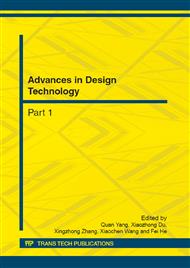p.592
p.597
p.602
p.607
p.612
p.616
p.621
p.626
p.635
Product Pedigree Based Conceptual Structure Evolutionary Design
Abstract:
By applying biological pedigree concept into product conceptual structure design, an conceptual structural design approach is set forth to make full use of creative and innovative intelligence of living systems for design automation. According to the relationship between different product structures with same function, the classification model of product pedigree is established, which can be used as unified functional isomorphic model during the intelligent conceptual design process. On the other hand, according to the evolutional logic from quality change to quantities change, pedigree based product evolutionary design strategy is given. Product pedigrees which are homology dependent are used as basic evolutionary models, based on which, the parameter based, interaction field based and interaction mater based evolutional conceptual design method are proposed, respectively. Based on the relation network of the pedigree units, multiple variant design schemes can be obtained, which is a strong backbone to the innovative design process. Finally, design examples are used to demonstrate the successful application of the proposed pedigree based evolutionary method in the product variant design.
Info:
Periodical:
Pages:
612-615
Citation:
Online since:
November 2012
Authors:
Price:
Сopyright:
© 2012 Trans Tech Publications Ltd. All Rights Reserved
Share:
Citation:


